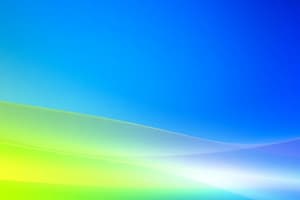Podcast
Questions and Answers
What is the smallest addressable graphical unit represented on a computer screen?
What is the smallest addressable graphical unit represented on a computer screen?
- Vector
- Pixel (correct)
- Byte
- Bit
Which of the following is an advantage of computer graphics?
Which of the following is an advantage of computer graphics?
- Typing documents
- Creating 3D printed objects
- Producing animations (correct)
- Sending emails
In computer graphics, what are graphics objects presented as?
In computer graphics, what are graphics objects presented as?
- Strings of text
- A collection of continuous lines
- 3D shapes
- A collection of discrete pixels (correct)
Which application example falls under 'Simulation and animation' in computer graphics?
Which application example falls under 'Simulation and animation' in computer graphics?
What does Computer Graphics provide tools for producing?
What does Computer Graphics provide tools for producing?
Which area of application involves designing automobile parts in computer graphics?
Which area of application involves designing automobile parts in computer graphics?
What is the process of representing continuous picture or graphics object as a collection of discrete pixels called?
What is the process of representing continuous picture or graphics object as a collection of discrete pixels called?
Which type of display device converts electrical energy into light?
Which type of display device converts electrical energy into light?
In which display system is the electron beam directed only to the parts of the screen where a picture is to be drawn?
In which display system is the electron beam directed only to the parts of the screen where a picture is to be drawn?
Which device is categorized under non-emissive displays?
Which device is categorized under non-emissive displays?
Flashcards are hidden until you start studying
Study Notes
What is Computer Graphics?
- Computer graphics is the art of drawing lines, charts, pictures, etc. using computers with the help of programming and tools.
- A computer graphics image is made up of a number of pixels, which is the smallest addressable graphical unit represented on the computer screen.
Advantages of Computer Graphics
- Most effective and commonly used way of communication with computers.
- Provides tools for producing pictures of “real-world”, synthetic objects, and data with no inherent geometry.
- Enables production of animations and simulations.
- Allows for interactive movements and observations.
Applications of Computer Graphics
- User interface: App icons
- Simulation and animation: Cartoon films
- Plotting of graphs and charts: Stock exchange
- Computer-aided drafting and design: Automobile parts designing
- Art and commerce: Creative pictures
- Cartography: Geographic maps
- Education and training: Models of physics
- Image processing: Editing photos
Basics of Computer Graphics
- Pictures or graphics objects are presented as a collection of discrete pixels.
- Intensity and color of pixels determine how the picture looks like.
- Rasterization is the process of determining which pixel will provide the best approximation to the desired picture or graphics object.
Display Devices
- Display devices are also known as output devices.
- Types of display devices:
- Cathode ray tube (CRT)
- Direct-view storage tubes (DVST)
- Plasma Panels displays
- Thin Film Electroluminescent Displays
- Light Emitting Diode (LED)
- Liquid Crystal Display (LCD)
- Three-dimensional viewing devices
- Stereoscopic system
- Virtual-reality
Cathode-Ray-Tubes
- Two techniques used for producing images on the CRT screen:
- Vector scan/Random scan display
- Raster scan display
Random Scan v/s Raster Scan
- Electron beam sweeps across the screen, one row at a time, from top to bottom in Raster Scan.
- Electron beam is directed only to the parts of screen where a picture is to be drawn in Random Scan.
- Raster Scan has poor resolution, while Random Scan has good resolution.
Color CRT Monitors
- Two basic techniques for color display:
- Beam-penetration technique
- Shadow-mask technique
Flat Panel Display
- Refers to a class of video devices with reduced volume, weight, and power requirement compared to CRT.
- Classified into two categories:
- Emissive displays (e.g. Plasma panel, Thin Film Electroluminescent Displays, Light Emitting Diode)
- Non-emissive displays (e.g. LCD)
Studying That Suits You
Use AI to generate personalized quizzes and flashcards to suit your learning preferences.




